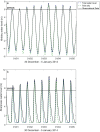Uncertainty in estuarine extreme water level predictions due to surge-tide interaction
- PMID: 30365514
- PMCID: PMC6203349
- DOI: 10.1371/journal.pone.0206200
Uncertainty in estuarine extreme water level predictions due to surge-tide interaction
Abstract
Storm surge is often the greatest threat to life and critical infrastructures during hurricanes and violent storms. Millions of people living in low-lying coastal zones and critical infrastructure within this zone rely on accurate storm surge forecast for disaster prevention and flood hazard mitigation. However, variability in residual sea level up-estuary, defined here as observed sea level minus predicted tide, can enhance total water levels; variability in the surge thus needs to be captured accurately to reduce uncertainty in site specific hazard assessment. Delft3D-FLOW is used to investigate surge variability, and the influence of storm surge timing on barotropic tide-surge propagation in a tide-dominant estuary using the Severn Estuary, south-west England, as an example. Model results show maximum surge elevation increases exponentially up-estuary and, for a range of surge timings consistently occurs on the flood tide. In the Severn Estuary, over a distance of 40 km from the most upstream tide gauge at Oldbury, the maximum surge elevation increases by 255%. Up-estuary locations experience short duration, high magnitude surge elevations and greater variability due to shallow-water effects and channel convergence. The results show that surge predictions from forecasting systems at tide gauge locations could under-predict the magnitude and duration of surge contribution to up-estuary water levels. Due to the large tidal range and dynamic nature of hyper-tidal estuaries, local forecasting systems should consider changes in surge elevation and shape with distance up-estuary from nearby tide gauge sites to minimize uncertainties in flood hazard assessment.
Conflict of interest statement
The authors have declared that no competing interests exist.
Figures




Similar articles
-
Viral dispersal in the coastal zone: A method to quantify water quality risk.Environ Int. 2019 May;126:430-442. doi: 10.1016/j.envint.2019.02.042. Epub 2019 Mar 2. Environ Int. 2019. PMID: 30836310
-
Dynamic responses and implications to coastal wetlands and the surrounding regions under sea level rise.PLoS One. 2018 Oct 12;13(10):e0205176. doi: 10.1371/journal.pone.0205176. eCollection 2018. PLoS One. 2018. PMID: 30312304 Free PMC article.
-
Conveying Flood Hazard Risk Through Spatial Modeling: A Case Study for Hurricane Sandy-Affected Communities in Northern New Jersey.Environ Manage. 2016 Oct;58(4):636-44. doi: 10.1007/s00267-016-0731-1. Epub 2016 Jun 24. Environ Manage. 2016. PMID: 27342852
-
Changing Tides: The Role of Natural and Anthropogenic Factors.Ann Rev Mar Sci. 2020 Jan 3;12:121-151. doi: 10.1146/annurev-marine-010419-010727. Epub 2019 Sep 3. Ann Rev Mar Sci. 2020. PMID: 31479622 Review.
-
The Big Flood: North Sea storm surge.Philos Trans A Math Phys Eng Sci. 2005 Jun 15;363(1831):1263-70. doi: 10.1098/rsta.2005.1567. Philos Trans A Math Phys Eng Sci. 2005. PMID: 16191649 Review.
Cited by
-
A new tropical cyclone surge index incorporating the effects of coastal geometry, bathymetry and storm information.Sci Rep. 2021 Aug 18;11(1):16747. doi: 10.1038/s41598-021-95825-7. Sci Rep. 2021. PMID: 34408207 Free PMC article.
References
-
- Lewis M, Horsburgh K, Bates P, Smith R. Quantifying the Uncertainty in Future Coastal Flood Risk Estimates for the UK. J Coast Res. 2011;27: 870–881. 10.2112/JCOASTRES-D-10-00147 - DOI
-
- Lewis M, Schumann G, Bates P, Horsburgh K. Understanding the variability of an extreme storm tide along a coastline. Estuar Coast Shelf Sci. Elsevier Ltd; 2013;123: 19–25. 10.1016/j.ecss.2013.02.009 - DOI
-
- Horsburgh KJ, Wilson C. Tide-surge interaction and its role in the distribution of surge residuals in the North Sea. J Geophys Res Ocean. 2007;112: 1–13. 10.1029/2006JC004033 - DOI
Publication types
MeSH terms
LinkOut - more resources
Full Text Sources
Medical

